Barriers and Potential Solutions in Diabetic Care
VerifiedAdded on 2023/01/18
|9
|2503
|30
AI Summary
This literature review focuses on the barriers and potential solutions in providing safer healthcare to diabetic patients. It also explores the role of nursing and changes in the field. The review includes research papers that discuss the challenges faced by healthcare professionals and suggest strategies for improvement. Subjects covered include diabetic care, nursing, and healthcare policies. The research papers are relevant for students studying healthcare, nursing, and related subjects.
Contribute Materials
Your contribution can guide someone’s learning journey. Share your
documents today.

LITERATURE REVIEW
Secure Best Marks with AI Grader
Need help grading? Try our AI Grader for instant feedback on your assignments.
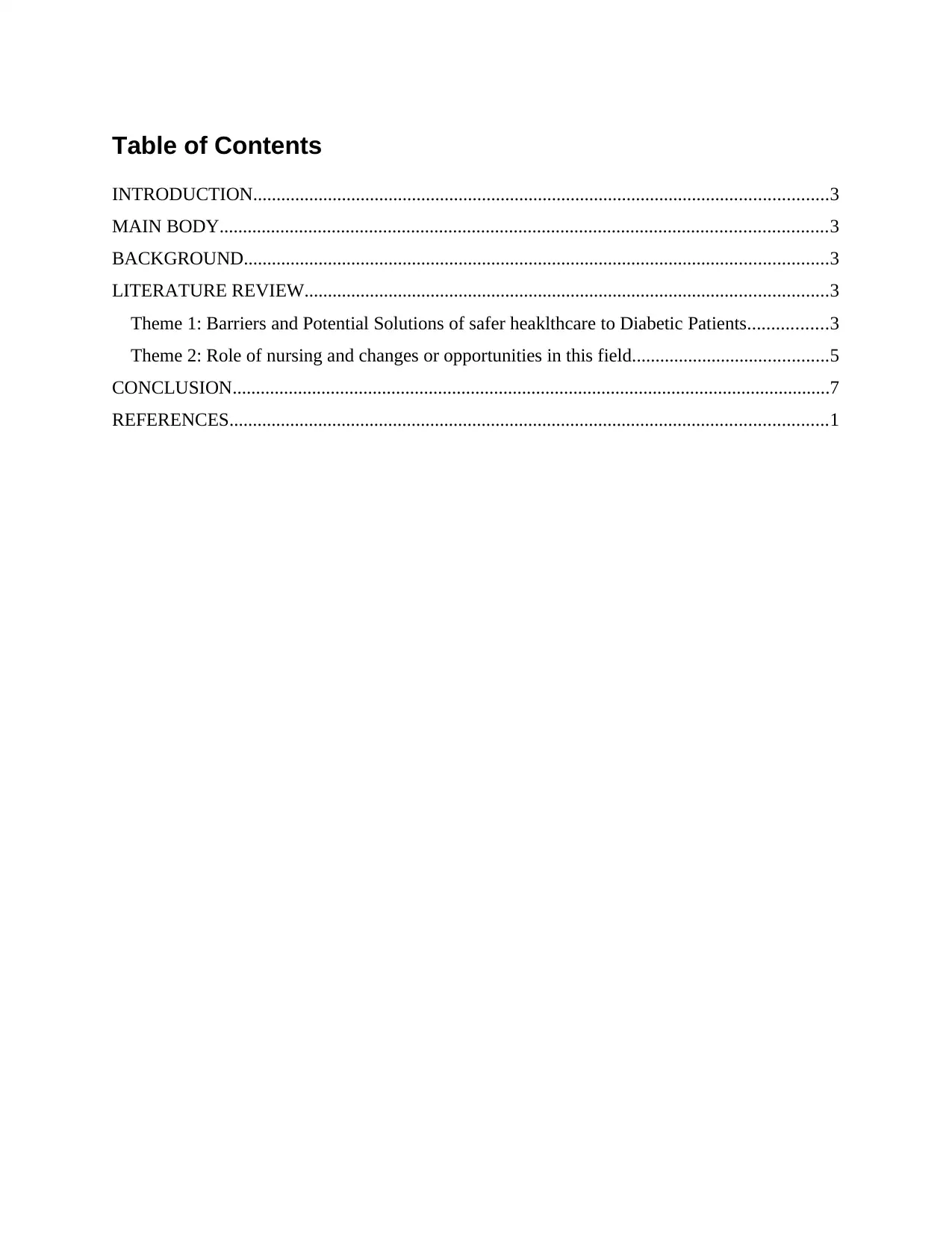
Table of Contents
INTRODUCTION...........................................................................................................................3
MAIN BODY..................................................................................................................................3
BACKGROUND.............................................................................................................................3
LITERATURE REVIEW................................................................................................................3
Theme 1: Barriers and Potential Solutions of safer heaklthcare to Diabetic Patients.................3
Theme 2: Role of nursing and changes or opportunities in this field..........................................5
CONCLUSION................................................................................................................................7
REFERENCES................................................................................................................................1
INTRODUCTION...........................................................................................................................3
MAIN BODY..................................................................................................................................3
BACKGROUND.............................................................................................................................3
LITERATURE REVIEW................................................................................................................3
Theme 1: Barriers and Potential Solutions of safer heaklthcare to Diabetic Patients.................3
Theme 2: Role of nursing and changes or opportunities in this field..........................................5
CONCLUSION................................................................................................................................7
REFERENCES................................................................................................................................1
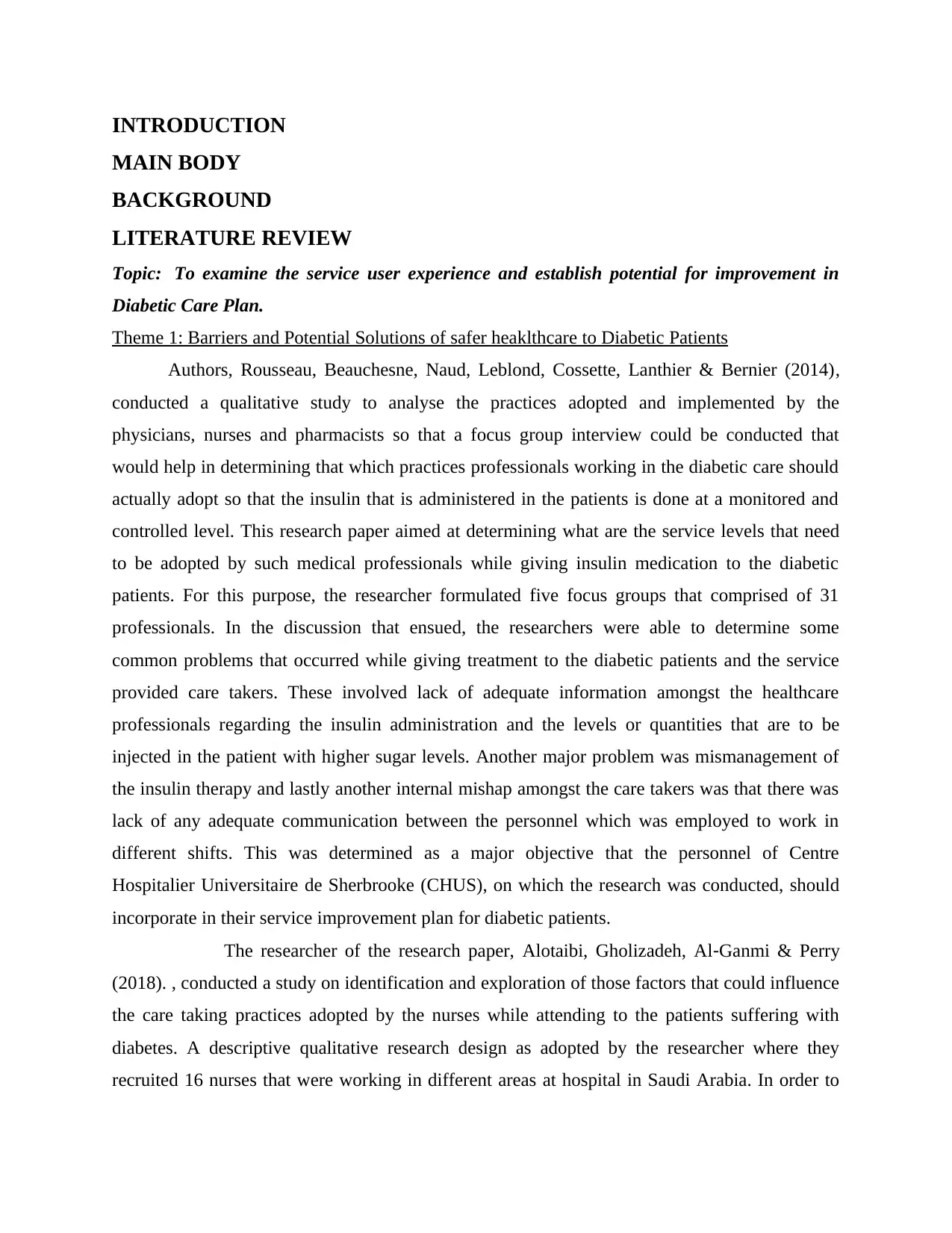
INTRODUCTION
MAIN BODY
BACKGROUND
LITERATURE REVIEW
Topic: To examine the service user experience and establish potential for improvement in
Diabetic Care Plan.
Theme 1: Barriers and Potential Solutions of safer heaklthcare to Diabetic Patients
Authors, Rousseau, Beauchesne, Naud, Leblond, Cossette, Lanthier & Bernier (2014),
conducted a qualitative study to analyse the practices adopted and implemented by the
physicians, nurses and pharmacists so that a focus group interview could be conducted that
would help in determining that which practices professionals working in the diabetic care should
actually adopt so that the insulin that is administered in the patients is done at a monitored and
controlled level. This research paper aimed at determining what are the service levels that need
to be adopted by such medical professionals while giving insulin medication to the diabetic
patients. For this purpose, the researcher formulated five focus groups that comprised of 31
professionals. In the discussion that ensued, the researchers were able to determine some
common problems that occurred while giving treatment to the diabetic patients and the service
provided care takers. These involved lack of adequate information amongst the healthcare
professionals regarding the insulin administration and the levels or quantities that are to be
injected in the patient with higher sugar levels. Another major problem was mismanagement of
the insulin therapy and lastly another internal mishap amongst the care takers was that there was
lack of any adequate communication between the personnel which was employed to work in
different shifts. This was determined as a major objective that the personnel of Centre
Hospitalier Universitaire de Sherbrooke (CHUS), on which the research was conducted, should
incorporate in their service improvement plan for diabetic patients.
The researcher of the research paper, Alotaibi, Gholizadeh, Al‐Ganmi & Perry
(2018). , conducted a study on identification and exploration of those factors that could influence
the care taking practices adopted by the nurses while attending to the patients suffering with
diabetes. A descriptive qualitative research design as adopted by the researcher where they
recruited 16 nurses that were working in different areas at hospital in Saudi Arabia. In order to
MAIN BODY
BACKGROUND
LITERATURE REVIEW
Topic: To examine the service user experience and establish potential for improvement in
Diabetic Care Plan.
Theme 1: Barriers and Potential Solutions of safer heaklthcare to Diabetic Patients
Authors, Rousseau, Beauchesne, Naud, Leblond, Cossette, Lanthier & Bernier (2014),
conducted a qualitative study to analyse the practices adopted and implemented by the
physicians, nurses and pharmacists so that a focus group interview could be conducted that
would help in determining that which practices professionals working in the diabetic care should
actually adopt so that the insulin that is administered in the patients is done at a monitored and
controlled level. This research paper aimed at determining what are the service levels that need
to be adopted by such medical professionals while giving insulin medication to the diabetic
patients. For this purpose, the researcher formulated five focus groups that comprised of 31
professionals. In the discussion that ensued, the researchers were able to determine some
common problems that occurred while giving treatment to the diabetic patients and the service
provided care takers. These involved lack of adequate information amongst the healthcare
professionals regarding the insulin administration and the levels or quantities that are to be
injected in the patient with higher sugar levels. Another major problem was mismanagement of
the insulin therapy and lastly another internal mishap amongst the care takers was that there was
lack of any adequate communication between the personnel which was employed to work in
different shifts. This was determined as a major objective that the personnel of Centre
Hospitalier Universitaire de Sherbrooke (CHUS), on which the research was conducted, should
incorporate in their service improvement plan for diabetic patients.
The researcher of the research paper, Alotaibi, Gholizadeh, Al‐Ganmi & Perry
(2018). , conducted a study on identification and exploration of those factors that could influence
the care taking practices adopted by the nurses while attending to the patients suffering with
diabetes. A descriptive qualitative research design as adopted by the researcher where they
recruited 16 nurses that were working in different areas at hospital in Saudi Arabia. In order to
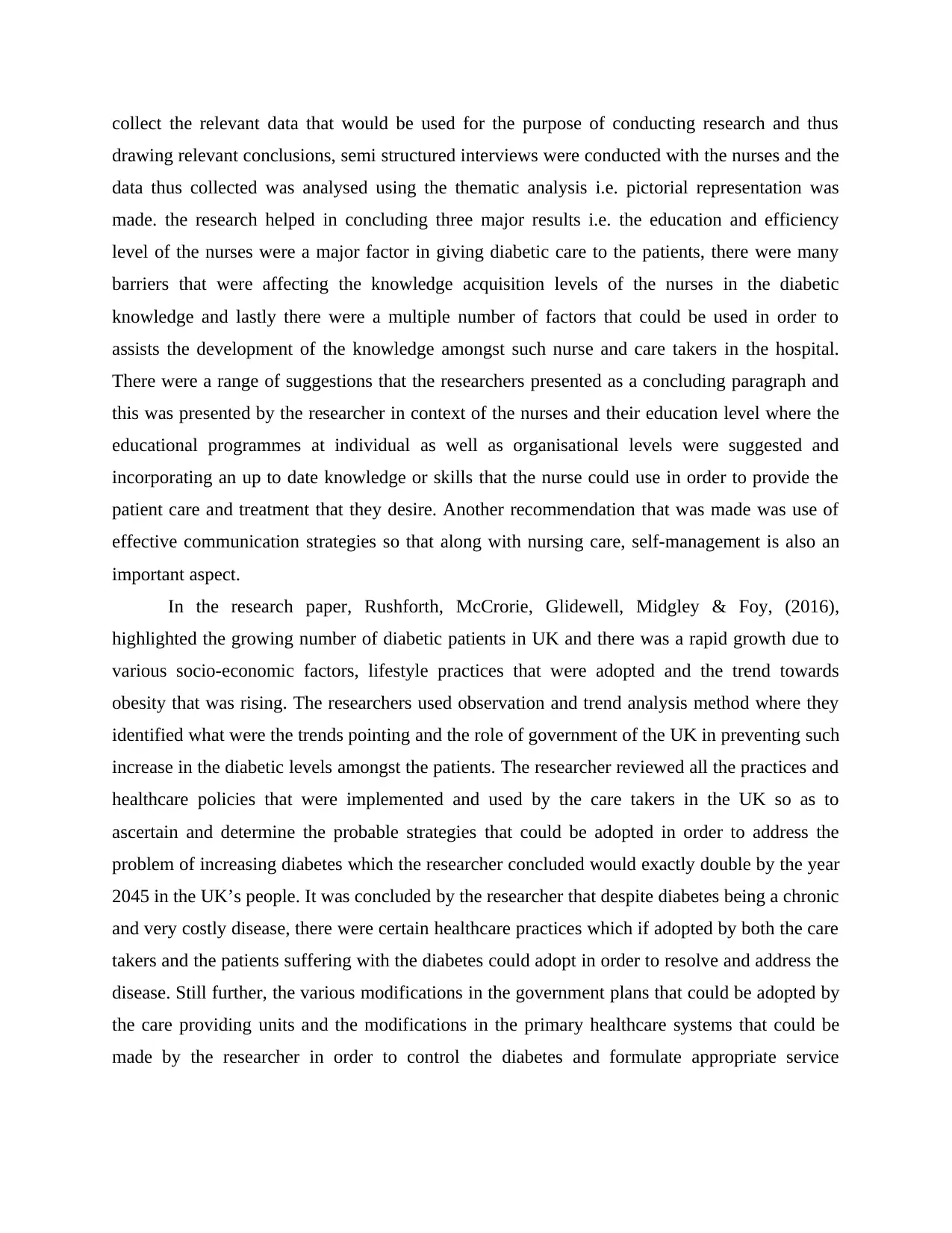
collect the relevant data that would be used for the purpose of conducting research and thus
drawing relevant conclusions, semi structured interviews were conducted with the nurses and the
data thus collected was analysed using the thematic analysis i.e. pictorial representation was
made. the research helped in concluding three major results i.e. the education and efficiency
level of the nurses were a major factor in giving diabetic care to the patients, there were many
barriers that were affecting the knowledge acquisition levels of the nurses in the diabetic
knowledge and lastly there were a multiple number of factors that could be used in order to
assists the development of the knowledge amongst such nurse and care takers in the hospital.
There were a range of suggestions that the researchers presented as a concluding paragraph and
this was presented by the researcher in context of the nurses and their education level where the
educational programmes at individual as well as organisational levels were suggested and
incorporating an up to date knowledge or skills that the nurse could use in order to provide the
patient care and treatment that they desire. Another recommendation that was made was use of
effective communication strategies so that along with nursing care, self-management is also an
important aspect.
In the research paper, Rushforth, McCrorie, Glidewell, Midgley & Foy, (2016),
highlighted the growing number of diabetic patients in UK and there was a rapid growth due to
various socio-economic factors, lifestyle practices that were adopted and the trend towards
obesity that was rising. The researchers used observation and trend analysis method where they
identified what were the trends pointing and the role of government of the UK in preventing such
increase in the diabetic levels amongst the patients. The researcher reviewed all the practices and
healthcare policies that were implemented and used by the care takers in the UK so as to
ascertain and determine the probable strategies that could be adopted in order to address the
problem of increasing diabetes which the researcher concluded would exactly double by the year
2045 in the UK’s people. It was concluded by the researcher that despite diabetes being a chronic
and very costly disease, there were certain healthcare practices which if adopted by both the care
takers and the patients suffering with the diabetes could adopt in order to resolve and address the
disease. Still further, the various modifications in the government plans that could be adopted by
the care providing units and the modifications in the primary healthcare systems that could be
made by the researcher in order to control the diabetes and formulate appropriate service
drawing relevant conclusions, semi structured interviews were conducted with the nurses and the
data thus collected was analysed using the thematic analysis i.e. pictorial representation was
made. the research helped in concluding three major results i.e. the education and efficiency
level of the nurses were a major factor in giving diabetic care to the patients, there were many
barriers that were affecting the knowledge acquisition levels of the nurses in the diabetic
knowledge and lastly there were a multiple number of factors that could be used in order to
assists the development of the knowledge amongst such nurse and care takers in the hospital.
There were a range of suggestions that the researchers presented as a concluding paragraph and
this was presented by the researcher in context of the nurses and their education level where the
educational programmes at individual as well as organisational levels were suggested and
incorporating an up to date knowledge or skills that the nurse could use in order to provide the
patient care and treatment that they desire. Another recommendation that was made was use of
effective communication strategies so that along with nursing care, self-management is also an
important aspect.
In the research paper, Rushforth, McCrorie, Glidewell, Midgley & Foy, (2016),
highlighted the growing number of diabetic patients in UK and there was a rapid growth due to
various socio-economic factors, lifestyle practices that were adopted and the trend towards
obesity that was rising. The researchers used observation and trend analysis method where they
identified what were the trends pointing and the role of government of the UK in preventing such
increase in the diabetic levels amongst the patients. The researcher reviewed all the practices and
healthcare policies that were implemented and used by the care takers in the UK so as to
ascertain and determine the probable strategies that could be adopted in order to address the
problem of increasing diabetes which the researcher concluded would exactly double by the year
2045 in the UK’s people. It was concluded by the researcher that despite diabetes being a chronic
and very costly disease, there were certain healthcare practices which if adopted by both the care
takers and the patients suffering with the diabetes could adopt in order to resolve and address the
disease. Still further, the various modifications in the government plans that could be adopted by
the care providing units and the modifications in the primary healthcare systems that could be
made by the researcher in order to control the diabetes and formulate appropriate service
Secure Best Marks with AI Grader
Need help grading? Try our AI Grader for instant feedback on your assignments.
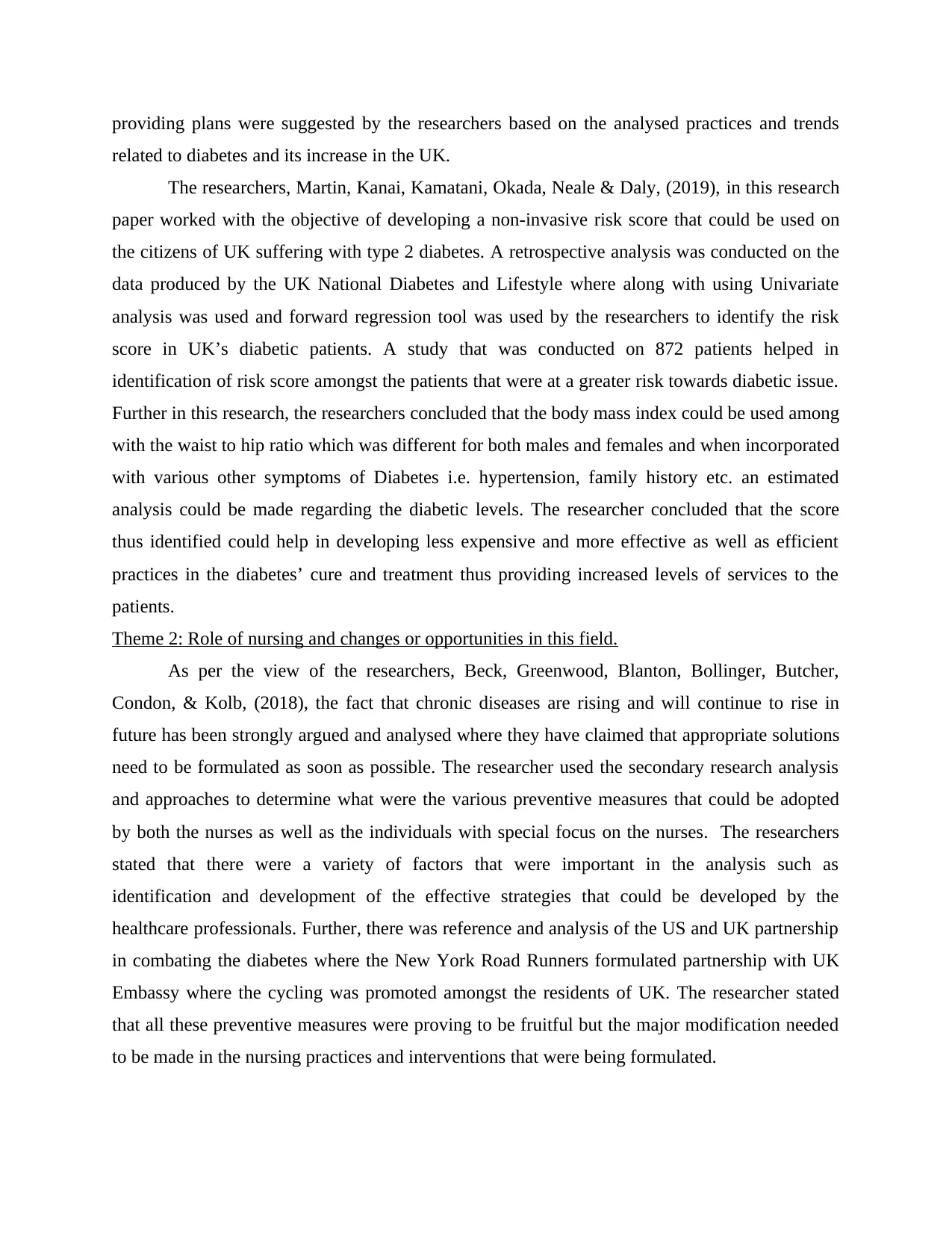
providing plans were suggested by the researchers based on the analysed practices and trends
related to diabetes and its increase in the UK.
The researchers, Martin, Kanai, Kamatani, Okada, Neale & Daly, (2019), in this research
paper worked with the objective of developing a non-invasive risk score that could be used on
the citizens of UK suffering with type 2 diabetes. A retrospective analysis was conducted on the
data produced by the UK National Diabetes and Lifestyle where along with using Univariate
analysis was used and forward regression tool was used by the researchers to identify the risk
score in UK’s diabetic patients. A study that was conducted on 872 patients helped in
identification of risk score amongst the patients that were at a greater risk towards diabetic issue.
Further in this research, the researchers concluded that the body mass index could be used among
with the waist to hip ratio which was different for both males and females and when incorporated
with various other symptoms of Diabetes i.e. hypertension, family history etc. an estimated
analysis could be made regarding the diabetic levels. The researcher concluded that the score
thus identified could help in developing less expensive and more effective as well as efficient
practices in the diabetes’ cure and treatment thus providing increased levels of services to the
patients.
Theme 2: Role of nursing and changes or opportunities in this field.
As per the view of the researchers, Beck, Greenwood, Blanton, Bollinger, Butcher,
Condon, & Kolb, (2018), the fact that chronic diseases are rising and will continue to rise in
future has been strongly argued and analysed where they have claimed that appropriate solutions
need to be formulated as soon as possible. The researcher used the secondary research analysis
and approaches to determine what were the various preventive measures that could be adopted
by both the nurses as well as the individuals with special focus on the nurses. The researchers
stated that there were a variety of factors that were important in the analysis such as
identification and development of the effective strategies that could be developed by the
healthcare professionals. Further, there was reference and analysis of the US and UK partnership
in combating the diabetes where the New York Road Runners formulated partnership with UK
Embassy where the cycling was promoted amongst the residents of UK. The researcher stated
that all these preventive measures were proving to be fruitful but the major modification needed
to be made in the nursing practices and interventions that were being formulated.
related to diabetes and its increase in the UK.
The researchers, Martin, Kanai, Kamatani, Okada, Neale & Daly, (2019), in this research
paper worked with the objective of developing a non-invasive risk score that could be used on
the citizens of UK suffering with type 2 diabetes. A retrospective analysis was conducted on the
data produced by the UK National Diabetes and Lifestyle where along with using Univariate
analysis was used and forward regression tool was used by the researchers to identify the risk
score in UK’s diabetic patients. A study that was conducted on 872 patients helped in
identification of risk score amongst the patients that were at a greater risk towards diabetic issue.
Further in this research, the researchers concluded that the body mass index could be used among
with the waist to hip ratio which was different for both males and females and when incorporated
with various other symptoms of Diabetes i.e. hypertension, family history etc. an estimated
analysis could be made regarding the diabetic levels. The researcher concluded that the score
thus identified could help in developing less expensive and more effective as well as efficient
practices in the diabetes’ cure and treatment thus providing increased levels of services to the
patients.
Theme 2: Role of nursing and changes or opportunities in this field.
As per the view of the researchers, Beck, Greenwood, Blanton, Bollinger, Butcher,
Condon, & Kolb, (2018), the fact that chronic diseases are rising and will continue to rise in
future has been strongly argued and analysed where they have claimed that appropriate solutions
need to be formulated as soon as possible. The researcher used the secondary research analysis
and approaches to determine what were the various preventive measures that could be adopted
by both the nurses as well as the individuals with special focus on the nurses. The researchers
stated that there were a variety of factors that were important in the analysis such as
identification and development of the effective strategies that could be developed by the
healthcare professionals. Further, there was reference and analysis of the US and UK partnership
in combating the diabetes where the New York Road Runners formulated partnership with UK
Embassy where the cycling was promoted amongst the residents of UK. The researcher stated
that all these preventive measures were proving to be fruitful but the major modification needed
to be made in the nursing practices and interventions that were being formulated.
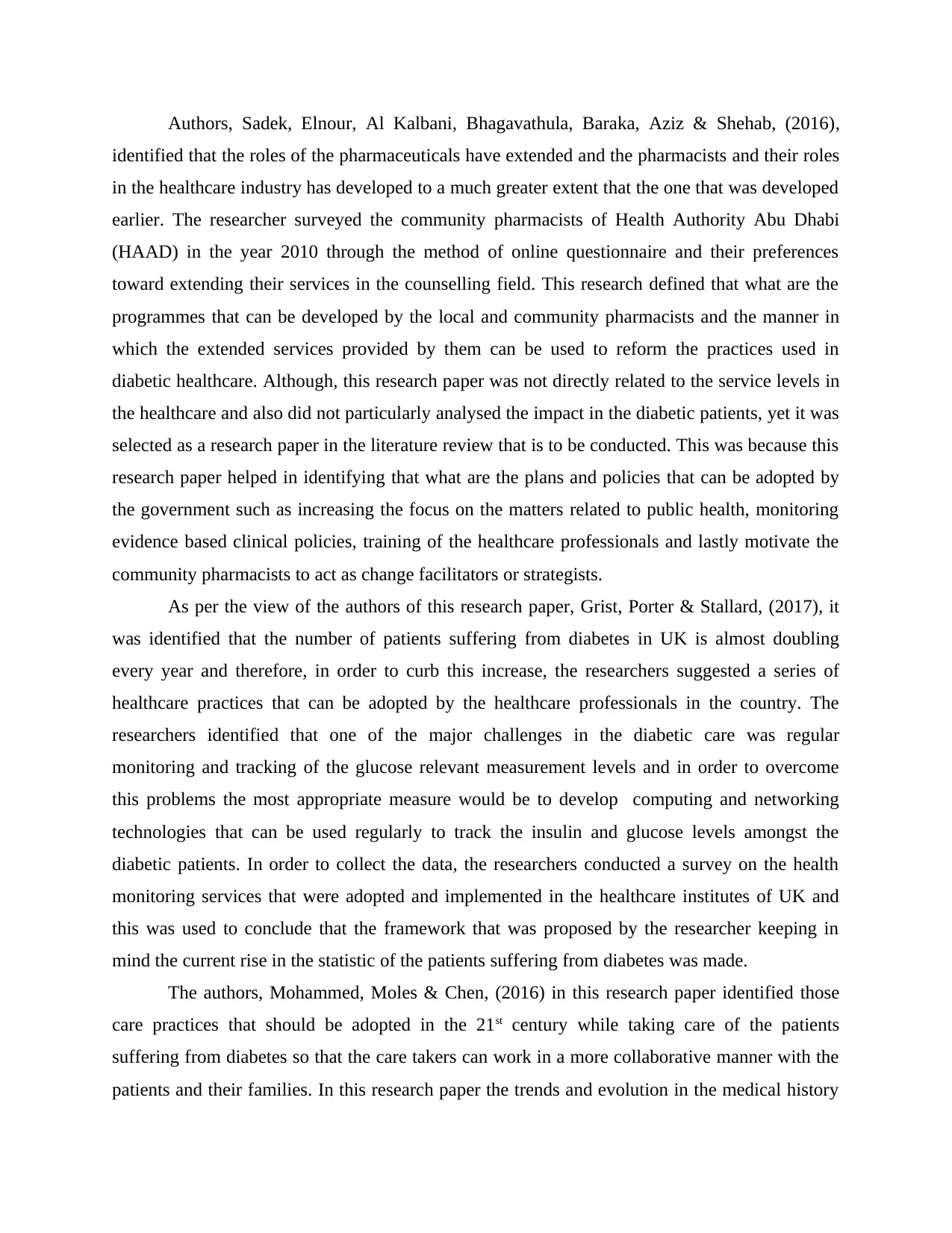
Authors, Sadek, Elnour, Al Kalbani, Bhagavathula, Baraka, Aziz & Shehab, (2016),
identified that the roles of the pharmaceuticals have extended and the pharmacists and their roles
in the healthcare industry has developed to a much greater extent that the one that was developed
earlier. The researcher surveyed the community pharmacists of Health Authority Abu Dhabi
(HAAD) in the year 2010 through the method of online questionnaire and their preferences
toward extending their services in the counselling field. This research defined that what are the
programmes that can be developed by the local and community pharmacists and the manner in
which the extended services provided by them can be used to reform the practices used in
diabetic healthcare. Although, this research paper was not directly related to the service levels in
the healthcare and also did not particularly analysed the impact in the diabetic patients, yet it was
selected as a research paper in the literature review that is to be conducted. This was because this
research paper helped in identifying that what are the plans and policies that can be adopted by
the government such as increasing the focus on the matters related to public health, monitoring
evidence based clinical policies, training of the healthcare professionals and lastly motivate the
community pharmacists to act as change facilitators or strategists.
As per the view of the authors of this research paper, Grist, Porter & Stallard, (2017), it
was identified that the number of patients suffering from diabetes in UK is almost doubling
every year and therefore, in order to curb this increase, the researchers suggested a series of
healthcare practices that can be adopted by the healthcare professionals in the country. The
researchers identified that one of the major challenges in the diabetic care was regular
monitoring and tracking of the glucose relevant measurement levels and in order to overcome
this problems the most appropriate measure would be to develop computing and networking
technologies that can be used regularly to track the insulin and glucose levels amongst the
diabetic patients. In order to collect the data, the researchers conducted a survey on the health
monitoring services that were adopted and implemented in the healthcare institutes of UK and
this was used to conclude that the framework that was proposed by the researcher keeping in
mind the current rise in the statistic of the patients suffering from diabetes was made.
The authors, Mohammed, Moles & Chen, (2016) in this research paper identified those
care practices that should be adopted in the 21st century while taking care of the patients
suffering from diabetes so that the care takers can work in a more collaborative manner with the
patients and their families. In this research paper the trends and evolution in the medical history
identified that the roles of the pharmaceuticals have extended and the pharmacists and their roles
in the healthcare industry has developed to a much greater extent that the one that was developed
earlier. The researcher surveyed the community pharmacists of Health Authority Abu Dhabi
(HAAD) in the year 2010 through the method of online questionnaire and their preferences
toward extending their services in the counselling field. This research defined that what are the
programmes that can be developed by the local and community pharmacists and the manner in
which the extended services provided by them can be used to reform the practices used in
diabetic healthcare. Although, this research paper was not directly related to the service levels in
the healthcare and also did not particularly analysed the impact in the diabetic patients, yet it was
selected as a research paper in the literature review that is to be conducted. This was because this
research paper helped in identifying that what are the plans and policies that can be adopted by
the government such as increasing the focus on the matters related to public health, monitoring
evidence based clinical policies, training of the healthcare professionals and lastly motivate the
community pharmacists to act as change facilitators or strategists.
As per the view of the authors of this research paper, Grist, Porter & Stallard, (2017), it
was identified that the number of patients suffering from diabetes in UK is almost doubling
every year and therefore, in order to curb this increase, the researchers suggested a series of
healthcare practices that can be adopted by the healthcare professionals in the country. The
researchers identified that one of the major challenges in the diabetic care was regular
monitoring and tracking of the glucose relevant measurement levels and in order to overcome
this problems the most appropriate measure would be to develop computing and networking
technologies that can be used regularly to track the insulin and glucose levels amongst the
diabetic patients. In order to collect the data, the researchers conducted a survey on the health
monitoring services that were adopted and implemented in the healthcare institutes of UK and
this was used to conclude that the framework that was proposed by the researcher keeping in
mind the current rise in the statistic of the patients suffering from diabetes was made.
The authors, Mohammed, Moles & Chen, (2016) in this research paper identified those
care practices that should be adopted in the 21st century while taking care of the patients
suffering from diabetes so that the care takers can work in a more collaborative manner with the
patients and their families. In this research paper the trends and evolution in the medical history
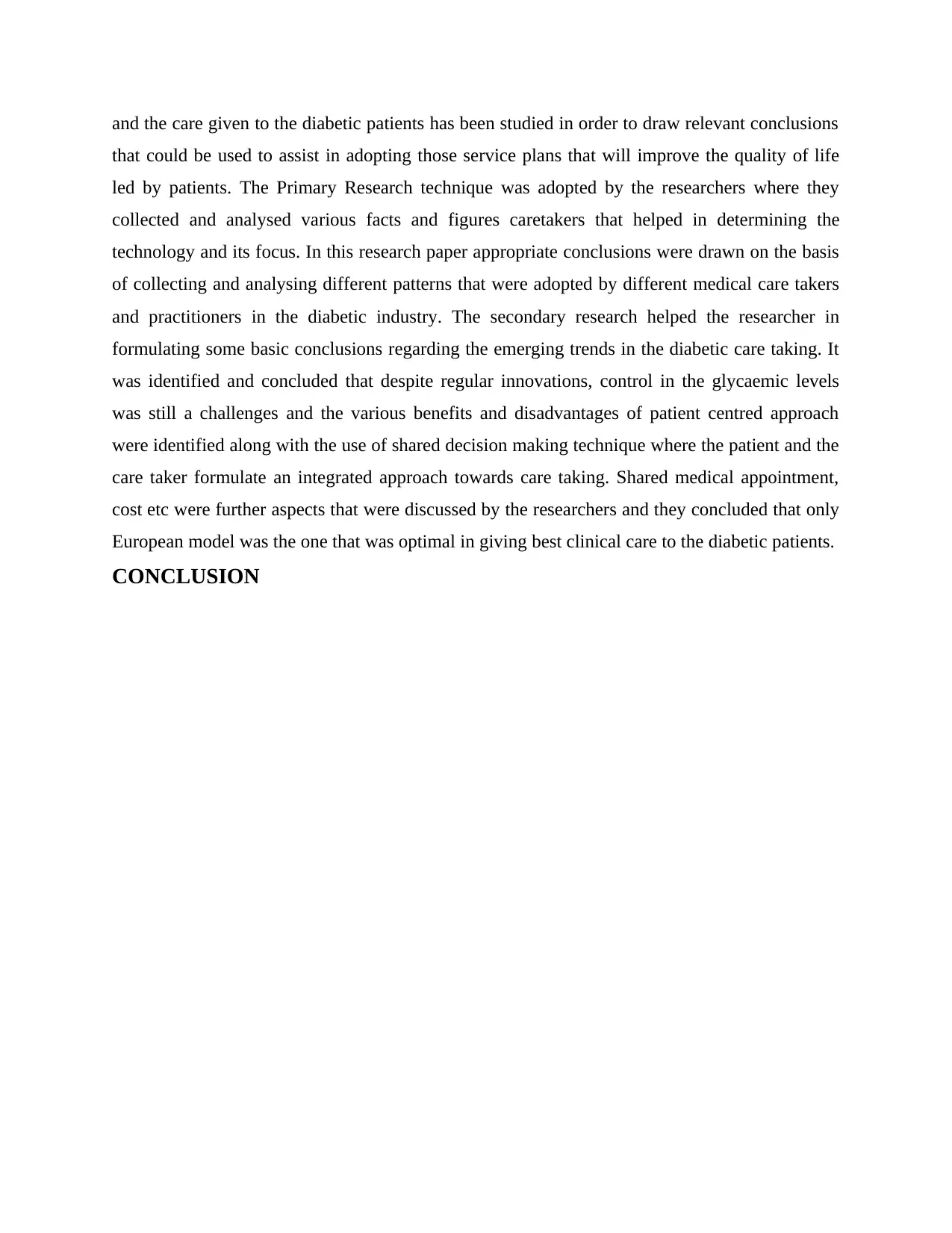
and the care given to the diabetic patients has been studied in order to draw relevant conclusions
that could be used to assist in adopting those service plans that will improve the quality of life
led by patients. The Primary Research technique was adopted by the researchers where they
collected and analysed various facts and figures caretakers that helped in determining the
technology and its focus. In this research paper appropriate conclusions were drawn on the basis
of collecting and analysing different patterns that were adopted by different medical care takers
and practitioners in the diabetic industry. The secondary research helped the researcher in
formulating some basic conclusions regarding the emerging trends in the diabetic care taking. It
was identified and concluded that despite regular innovations, control in the glycaemic levels
was still a challenges and the various benefits and disadvantages of patient centred approach
were identified along with the use of shared decision making technique where the patient and the
care taker formulate an integrated approach towards care taking. Shared medical appointment,
cost etc were further aspects that were discussed by the researchers and they concluded that only
European model was the one that was optimal in giving best clinical care to the diabetic patients.
CONCLUSION
that could be used to assist in adopting those service plans that will improve the quality of life
led by patients. The Primary Research technique was adopted by the researchers where they
collected and analysed various facts and figures caretakers that helped in determining the
technology and its focus. In this research paper appropriate conclusions were drawn on the basis
of collecting and analysing different patterns that were adopted by different medical care takers
and practitioners in the diabetic industry. The secondary research helped the researcher in
formulating some basic conclusions regarding the emerging trends in the diabetic care taking. It
was identified and concluded that despite regular innovations, control in the glycaemic levels
was still a challenges and the various benefits and disadvantages of patient centred approach
were identified along with the use of shared decision making technique where the patient and the
care taker formulate an integrated approach towards care taking. Shared medical appointment,
cost etc were further aspects that were discussed by the researchers and they concluded that only
European model was the one that was optimal in giving best clinical care to the diabetic patients.
CONCLUSION
Paraphrase This Document
Need a fresh take? Get an instant paraphrase of this document with our AI Paraphraser
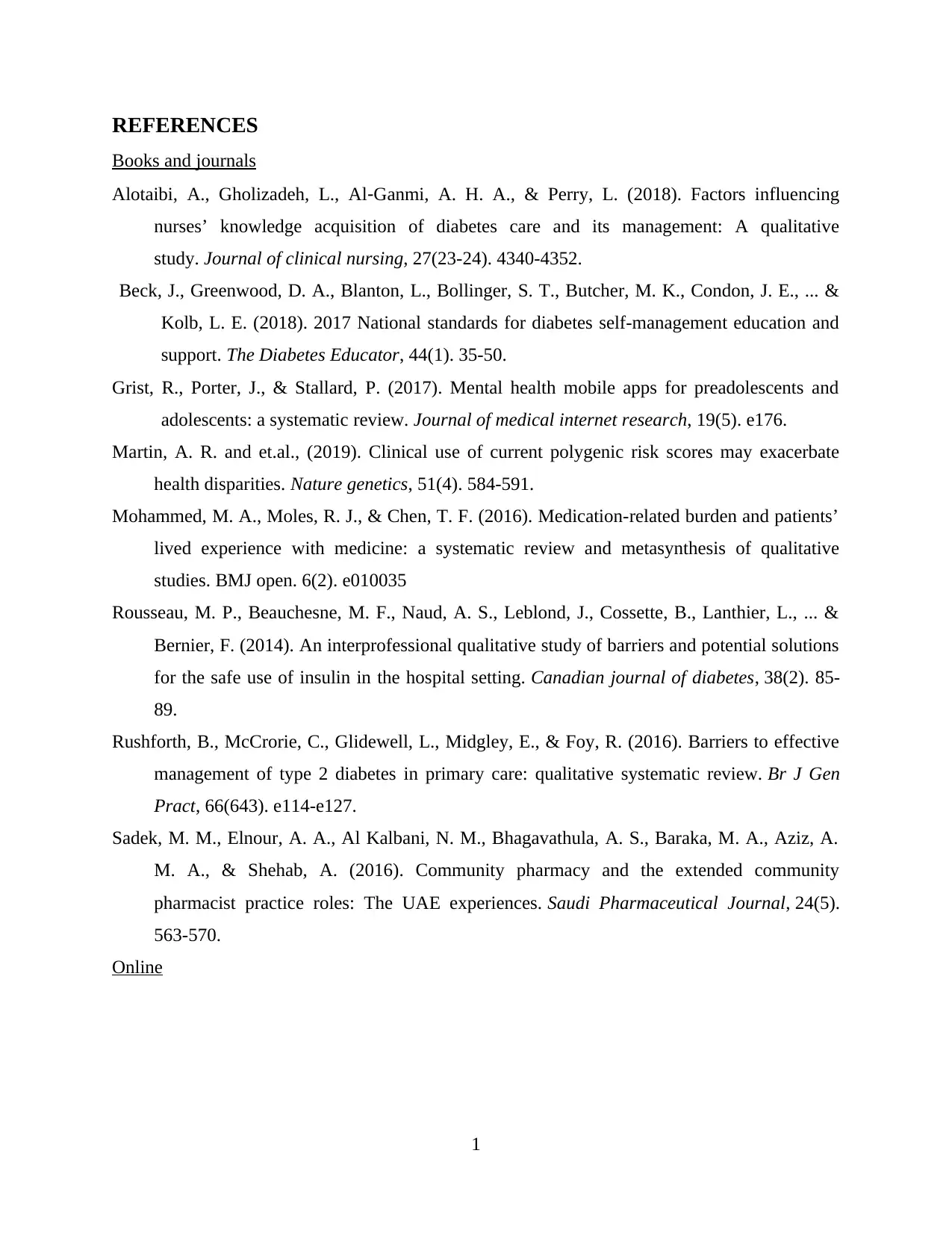
REFERENCES
Books and journals
Alotaibi, A., Gholizadeh, L., Al‐Ganmi, A. H. A., & Perry, L. (2018). Factors influencing
nurses’ knowledge acquisition of diabetes care and its management: A qualitative
study. Journal of clinical nursing, 27(23-24). 4340-4352.
Beck, J., Greenwood, D. A., Blanton, L., Bollinger, S. T., Butcher, M. K., Condon, J. E., ... &
Kolb, L. E. (2018). 2017 National standards for diabetes self-management education and
support. The Diabetes Educator, 44(1). 35-50.
Grist, R., Porter, J., & Stallard, P. (2017). Mental health mobile apps for preadolescents and
adolescents: a systematic review. Journal of medical internet research, 19(5). e176.
Martin, A. R. and et.al., (2019). Clinical use of current polygenic risk scores may exacerbate
health disparities. Nature genetics, 51(4). 584-591.
Mohammed, M. A., Moles, R. J., & Chen, T. F. (2016). Medication-related burden and patients’
lived experience with medicine: a systematic review and metasynthesis of qualitative
studies. BMJ open. 6(2). e010035
Rousseau, M. P., Beauchesne, M. F., Naud, A. S., Leblond, J., Cossette, B., Lanthier, L., ... &
Bernier, F. (2014). An interprofessional qualitative study of barriers and potential solutions
for the safe use of insulin in the hospital setting. Canadian journal of diabetes, 38(2). 85-
89.
Rushforth, B., McCrorie, C., Glidewell, L., Midgley, E., & Foy, R. (2016). Barriers to effective
management of type 2 diabetes in primary care: qualitative systematic review. Br J Gen
Pract, 66(643). e114-e127.
Sadek, M. M., Elnour, A. A., Al Kalbani, N. M., Bhagavathula, A. S., Baraka, M. A., Aziz, A.
M. A., & Shehab, A. (2016). Community pharmacy and the extended community
pharmacist practice roles: The UAE experiences. Saudi Pharmaceutical Journal, 24(5).
563-570.
Online
1
Books and journals
Alotaibi, A., Gholizadeh, L., Al‐Ganmi, A. H. A., & Perry, L. (2018). Factors influencing
nurses’ knowledge acquisition of diabetes care and its management: A qualitative
study. Journal of clinical nursing, 27(23-24). 4340-4352.
Beck, J., Greenwood, D. A., Blanton, L., Bollinger, S. T., Butcher, M. K., Condon, J. E., ... &
Kolb, L. E. (2018). 2017 National standards for diabetes self-management education and
support. The Diabetes Educator, 44(1). 35-50.
Grist, R., Porter, J., & Stallard, P. (2017). Mental health mobile apps for preadolescents and
adolescents: a systematic review. Journal of medical internet research, 19(5). e176.
Martin, A. R. and et.al., (2019). Clinical use of current polygenic risk scores may exacerbate
health disparities. Nature genetics, 51(4). 584-591.
Mohammed, M. A., Moles, R. J., & Chen, T. F. (2016). Medication-related burden and patients’
lived experience with medicine: a systematic review and metasynthesis of qualitative
studies. BMJ open. 6(2). e010035
Rousseau, M. P., Beauchesne, M. F., Naud, A. S., Leblond, J., Cossette, B., Lanthier, L., ... &
Bernier, F. (2014). An interprofessional qualitative study of barriers and potential solutions
for the safe use of insulin in the hospital setting. Canadian journal of diabetes, 38(2). 85-
89.
Rushforth, B., McCrorie, C., Glidewell, L., Midgley, E., & Foy, R. (2016). Barriers to effective
management of type 2 diabetes in primary care: qualitative systematic review. Br J Gen
Pract, 66(643). e114-e127.
Sadek, M. M., Elnour, A. A., Al Kalbani, N. M., Bhagavathula, A. S., Baraka, M. A., Aziz, A.
M. A., & Shehab, A. (2016). Community pharmacy and the extended community
pharmacist practice roles: The UAE experiences. Saudi Pharmaceutical Journal, 24(5).
563-570.
Online
1

2
1 out of 9
Related Documents
Your All-in-One AI-Powered Toolkit for Academic Success.
+13062052269
info@desklib.com
Available 24*7 on WhatsApp / Email
![[object Object]](/_next/static/media/star-bottom.7253800d.svg)
Unlock your academic potential
© 2024 | Zucol Services PVT LTD | All rights reserved.




